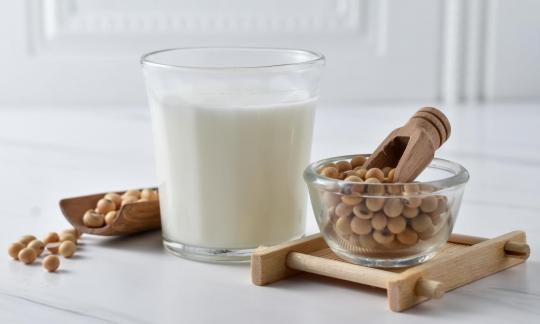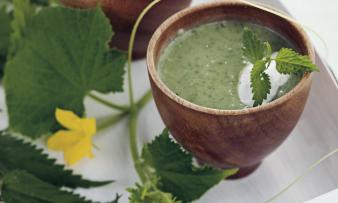Table of contents
Soy cream, also called soy cuisine or soy cream, is a plant-based, vegan cream substitute. Sometimes also available in organic quality, conventionally produced soy cream is never raw.
Use in the kitchen
Soy cream, soy cuisine or soy cream are different names for vegan whipped cream or vegan cream made from soybeans, which is a plant-based alternative to conventional cream made from cow's milk. Soy cream is a creamy liquid that can be used in a similar way to cow's milk cream. Soy cream is mainly used by people who are allergic to cow's milk or who are lactose intolerant, as soy cream is lactose-free. It is also a popular plant-based alternative for vegans. People with a soy allergy who cannot tolerate soy cream can use oat cream or coconut cream in the kitchen.
Soy cream is made by mixing soy milk and oil (eg rapeseed oil) in a ratio of 2:1, although less oil can be added depending on the desired fat content. Stabilizers and natural emulsifiers are often added as well. Soy cream can be found in regular supermarkets, or you can simply make it yourself from soy milk and oil.
Soya Cuisine is used to refine savoury dishes such as casseroles, gratins, stir-fries, purees or all kinds of soups. Examples of recipes with soya cream are creamed spinach, mushroom or tomato cream sauce and nettle potato soup. It can also be used to make icing for potato gratin or fruit tart. In savoury dishes, the flavour is almost unrecognisable. Sweet dishes such as pudding, chocolate mousse, vanilla cream, rice pudding or porridge can be made excellently with soya cream. Soya Cuisine is also suitable for refining cakes.
Can you whip soy cream until stiff? To make soy cream, mix 2 g of agar-agar with 500 ml of soy cream and bring to the boil for around 2 minutes. Allow the mixture to cool well and then whip it with a hand blender or whisk.
Making your own soy cream
Soy cream is made from fermented soybeans and water, just like soy milk. However, it is more concentrated and thicker. Commercially produced soy cream usually contains emulsifiers and stabilizers in addition to soybeans and vegetable oil. Homemade soy cream is free of these additives, provided the soy milk you use does not contain any. That is why it is worth making your own soy milk and then mixing it with rapeseed oil. The following link takes you to our recipe for soy cream with rapeseed oil instead of olive oil. We recommend cold-pressed rapeseed oil, as it has a good omega-3 to omega-6 ratio.
Alternatively, you can also use linseed oil or walnut oil.
Vegan recipe for fruit salad with soy whipped cream
Ingredients (for 4 people): 1 papaya, 3 green kiwis, 1/2 watermelon, juice of one lemon, 1 cm ginger, 1 bunch of peppermint, 500 ml soy cream, 2 g agar-agar.
Preparation: Halve the papaya, remove the seeds and peel. Peel the kiwi and watermelon. Cut all the fruit into bite-sized pieces. Finely grate the ginger with a hand grater. Put the fruit and ginger in a bowl and mix with lemon juice. Leave to steep for about 30 minutes.
In a small saucepan, mix the agar-agar into the whipped cream. A whisk is best for this. Bring the mixture to the boil for around two minutes, stirring occasionally. Then remove from the heat and allow to cool. As soon as the cream has cooled, it is ready to be whipped. Do this until the soy whipped cream has reached the desired consistency.
Stir the fruit salad again and portion it into small bowls and garnish with a dollop of soy whipped cream.
Vegan recipes with soy cream (soy cuisine) can be found under the note: " Recipes that have the most of this ingredient ".
| Not only vegans or vegetarians should read this: Vegans often eat unhealthily. Avoidable nutritional errors. |
Purchasing - Storage
Soy cream can be found in stores under the names Soy Cuisine, Soy Cooking Cream and Soy Cream.
You can buy soy cream, sometimes even in organic quality, from major retailers such as Coop, Migros, Spar, Rewe, Edeka and Billa. You won't find it in the standard range at discounters such as Denner, Volg, Aldi, Lidl and Hofer (as of 2024). Soy cream is also available in organic supermarkets such as Denn's Biomarkt and Alnatura.
Conventionally produced soy cream usually contains soybeans, water and vegetable oils as well as emulsifiers and stabilizers. Due to the heating during production, conventionally produced soy cream is not of raw food quality.
The availability of soy cream (Soja Cuisine) varies depending on the size of the store, catchment area, etc. You can find our recorded food prices for the DA-CH countries above under the ingredient image - and by clicking you can see their development at various suppliers.
Storage tips:
Unopened and unrefrigerated, soy cream will last for several months (see best before date on the packaging). Once opened, soy cream should be stored in the refrigerator and used within 4-5 days.
Ingredients - Nutritional values - Calories
Soy cream according to the recipe Soy cream with rapeseed oil instead of olive oil has an energy content of 310 kcal per 100 g. The fat content is very high at 32 g/100g. This corresponds to 45.8% of the recommended maximum daily intake. Soy cream has 4.3 g carbohydrates and 2.3 g protein per 100 g. 1
The proportion of alpha-linolenic acid (an essential omega-3 fatty acid) in soy cream with rapeseed oil is 2.9 g/100g. Linoleic acid (omega-6 fatty acid) is 6.1 g/100g. 1 From a nutritional point of view, the ratio is about 2:1 (LA:ALA). Many recipes for making soy cream contain olive oil, which has a poorer ratio of 12:1. According to the Federal Nutrition Commission (EEK), the ratio should not exceed 5:1 per day.
Vitamin E is also contained in large quantities. 100 g of soy cream contains 5.5 mg of vitamin E, which corresponds to 45% of the daily requirement. Peanut butter (6.3 mg) and hydrogenated vegetable fat (6.1 mg) have a similarly high value. The vitamin E comes mainly from the added cold-pressed rapeseed oil, which contains 17 mg/100 g. 1
The vitamin K content is 24 µg/100g, which corresponds to 32% of the daily requirement. Miso has a similar value (29 µg/100g), but only a few grams of it are consumed. Cold-pressed rapeseed oil contains 71 µg/100g. 1
Furthermore, there are small amounts of manganese, folate and selenium, as well as the essential amino acids tryptophan and threonine. 1
The complete ingredients of soy cream (Soja Cuisine), the coverage of the daily requirement and comparison values with other ingredients can be found in our nutrient tables. In the article Nutrients explained you will get a detailed insight into the topic.
Health effects
Is soy cream healthy? From a nutritional point of view, soy milk and soy cream are the best alternative to cow's milk. 15 A comparison of various plant-based drinks with cow's milk showed that soy milk has a similar protein content to cow's milk.Soybeans and soy products made from them are a good vegan protein source because the ripe seeds contain all eight essential amino acids. 1 Although the methionine content in raw soybeans is lower than the other seven essential amino acids, this value can still keep up with animal sources; see our nutrient description of methionine.
Unlike cow's milk and cream, soy milk and soy cream are free of cholesterol and lactose. 14
Secondary plant substances
Many of the health effects of soy cream can be attributed to the secondary plant substances it contains. Our article on secondary plant substances provides an overview of the classification of substance groups, their occurrence in foods and possible effects on humans.
Soybeans contain several secondary plant substances. They are particularly known for the isoflavones they contain, which are similar to the sex hormone estrogen and are therefore classified as phytoestrogens. They also contain saponins, phytic acid, trypsin inhibitors, phytosterols, phenolic acids and lectins. 16
However, it should be noted that the composition of the secondary plant substances in soy cream can vary depending on the variety, time of harvest and growing conditions of the soybeans and can change during the production of the soy cream. Therefore, quantities are only of limited use and should only be understood roughly.
Dangers - Intolerances - Side effects
Soy is one of the 14 main allergens. Soy contains protein components, eight of which are classified as allergens. Particularly important allergens are β-conglycinin (Gly m5) and glycinin (Gly m6), as both can trigger severe reactions. 2 Certain soy allergens are not heat-resistant, which is why some allergy sufferers can tolerate processed products. 3 However, this does not apply to all soy allergens, which is why people with severe allergies should completely avoid soy products. 2
People who are allergic to flower pollen should also be careful, as a cross-allergy with soya can occur (especially in the case of birch pollen allergy). Symptoms often appear immediately after ingesting soya products and manifest themselves in itching and swelling in the mouth and throat. Gastrointestinal complaints and skin rashes can occur with a time delay. 3
When it comes to industrially produced soy cream, you have to pay attention to the fats used: coconut oil, hydrogenated palm oil or hydrogenated soy oil are also often used in the production of soy cuisine. Sugar, emulsifiers, stabilizers and thickeners are often added to the soy cream to give it a longer shelf life and viscosity.
Ecological footprint - animal welfare
Different aspects, such as the cultivation method (conventional/organic), seasonality, country of origin, transport as well as production processes and packaging, have an influence on the ecological footprint of soy cream. According to CarbonCloud, the carbon footprint of soybeans is 1.26 kg CO 2 eq/kg in Brazil, 0.44 kg CO 2 eq/kg in the United States of America and 0.35 kg CO 2 eq/kg in Argentina. 18 No data is available for soy cream, but there is data for soy milk (soy drink): 0.39 CO 2 eq/kg for a Swedish product and 0.45 CO 2 eq/kg for a product from the UK. 19 In addition to processing, packaging also plays a major role here.
Despite extensive research, we were unable to find any significant figures on the water footprint of soy cream. The global average water consumption for soybeans is around 2145 l/kg and for soy milk 3763 l/kg. 11
Excessive soy cultivation is leading to the deforestation of large parts of the rainforest in Brazil, Paraguay and Bolivia. 1 The change in land use from rainforest to arable land releases large amounts of CO 2, especially in the case of large-scale slash-and-burn practices. 10 In Brazil, genetically modified soy is mainly grown, which is resistant to certain herbicides. This is why herbicides are used on a large scale to destroy weeds in monocultures. The massive use is ecologically questionable and the negative effects on soil fertility and biodiversity should not be underestimated.
Economically, the export of soybeans is a significant source of income for countries such as Brazil and Argentina, but only a small part of the population benefits from it. On the contrary, growing soybeans on land that was previously used for subsistence can even endanger the food supply and livelihood of the local population. 10
Around 76% of the soybeans grown worldwide are used as animal feed for meat and milk production (2017-2019). Only around 20% of the soybeans and the products made from them (cooking oil, tofu, miso, etc.) are eaten directly by humans. A small part of the harvest is processed into biodiesel and lubricants (around 4%). 9
For detailed explanations of various sustainability indicators (such as ecological footprint, CO2 footprint, water footprint), see our article: What does the ecological footprint mean?.
Animal welfare - species protection
The direct environmental impacts in the affected regions are even more serious. The expansion of soy cultivation leads to the loss of remarkable and biologically unique habitats for plants and animals (loss of biodiversity). 12 The clearing of huge areas of forest and savannah (especially the Amazon and Cerrado regions) not only endangers local water resources, but also global water cycles. Droughts in neighboring areas are increasing and monoculture cultivation leads to soil degradation and water pollution in neighboring rivers and wetlands. 13
Worldwide occurrence - cultivation
Soy cream is made from soybeans. The cultivation of soybeans took place in China around 5,000-6,000 years ago. 4 Thanks to the wide range of processing and application options, the soybean is one of the most important economic crops in the world. According to the FAO, the most important growing countries in 2020 are Brazil, the United States, Argentina and the People's Republic of China. Around 355,866,426 tonnes of soybeans were grown worldwide in 2020, with Brazil alone (as the largest producer) producing 121,820,949 tonnes. 5
Since 1997, a genetically modified (transgenic) soybean has been approved in certain countries to make weed control easier. 7 In 2019, 76% of the beans produced worldwide were genetically modified soy. 6 GMO-free soy is grown mainly in Europe, although Brazil and Russia also grow some non-GMO soybeans. 17
Cultivation - Harvest
Information can be found in our article about soybeans.
Industrial production
Soy cream is produced from fatty soy milk. To do this, soy beans are mixed with water and the mixture is pureed. The solid components are then removed by centrifugation or filtration and the raw soy milk is heated. To produce soy cream, either another centrifugation is used in combination with the extraction of water or enzymes are used for coagulation. Coagulants for separating the soy cream from the watery components of the soy milk are enzymes such as papain ( papaya), ficain ( fig) and bromelain ( pineapple), as well as rennet and pepsin. To obtain the desired viscosity and to support coagulation, the soy-enzyme mixture is heated. For example, if papain is added, it is heated for 30 minutes at 50°C. The soy cream is then heated for 10 minutes at 100°C to neutralize the enzyme. 17
Further information
The soybean ( Glycine max (L.) Merr.) is a plant species from the Faboideae subfamily, which belongs to the Leguminosae or Fabaceae family. It grows bushily to a height of 40-90 cm. The plant has a deep taproot. Special bacteria live on this root. The nodule bacteria and the plant enter into a symbiotic relationship. Together they can extract the nitrogen they need from the air. 8
Alternative names
Alternative names for soy cream are soy cuisine, soy cream cuisine, soy cream and soy cream. The English name is soy cream or soymilk cream.
Bibliography - 19 Sources
| 1. | USDA United States Department of Agriculture. |
| 2. | Medizinische Universität Wien. Faktencheck Nahrungsmittelallergie. 14 wichtigste Allergene. |
| 3. | Bundesinstitut für Risikobewertung (BfR). Birkenpollenallergiker können auf Sojaprodukte besonders empfindlich reagieren. 2007. |
| 4. | Wang KJ, Li XH, Liu Y. Fine-scale phylogenetic structure and major events in the history of the current wild soybean (Glycine soja) and taxonomic assignment of semi-wild type (Glycine gracilis Skvortz.) within the Chinese subgenus Soja. J Hered. 2012;103(1):13-27. |
| 5. | FAOSTAT Food and Agriculture Organization of the United Nations. Soya Beans. Production Quantity. 2020. |
| 6. | Transgen.de Gentechnisch veränderte Sojabohnen: Anbauflächen weltweit. 2021. |
| 7. | Transgen.de Sojabohne. 2022. |
| 8. | Bäumler S. Heilpflanzenpraxis Heute: Arzneipflanzenporträts. 3. Auflage. München: Elsevier; 2021. |
| 9. | Ourworldindata.org Soy. 2021. |
| 10. | Bundesinformationszentrum Landwirtschaft. Soja - Nahrungsmittel für Tier und Mensch. 2022. |
| 11. | Mekonnen MM, Hoeskstra AY. The green, blue and grey water footprint of crops and derived corp products. Hydrol. Earth Syst. Sci. 2011;15(5):1577-1600. |
| 12. | WWF International. Der Sojaboom - Auswirkungen und Lösungswege. Report 2014. |
| 13. | WWF Deutschland. Soja: Wunderbohne mit riskanten Nebenwirkungen. 2020. |
| 14. | Hossen MM, Uddin MN et al. Nutritional and in vitro antioxidant activity analysis of formulated soymilk dessert. Heliyon. 2022;8(19):e11267. |
| 15. | Vanga SK, Raghavan V. How well do plant based alternatives fare nutritionally compared to cow’s milk? J Food Sci Technol. 2018;55(1):10–20. |
| 16. | Silva ARA, Silva MMN, Ribeiro BD. Health issues and technological aspects of plant-based alternative milk. Food Research International. 2020;131:108972. |
| 17. | Abe N, Wu CY et al. Development of an efficient soymilk cream production method by papain digestion, heat treatment, and low-speed centrifugation. Biosci Biotechnol Biochem. 2015;79(11):1890-1892. |
| 18. | CarbonCloud.com Soybean: Argentinien, Brasilien, Vereinigte Staaten von Amerika. |
| 19. |











Comments